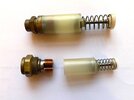The magnetic flux created by the electrical power from the thermocouple does not pull in the valve mechanism.
The mechanism is "pulled in" mechanically by the person pressing the button which opens the gas valve and also closes the magnetic path by bringing the magnetic faces into contact with each other .
When the magnetic path is closed it requires very little magnetic flux to keep the magnetic faces in contact with each other.,
EDIT the word mechanically added
Agreed, but why would this need an earth connection?
John - Thought about an earth rod but not sure how that affects the MCB and RCD trip.
This seems to be a continuation, and I seem to remember the post was about using non mains power, but the title seems to have changed to "Solenoids and Thermocouples" not sure what has happened here? The relay is more than a simple solenoid
and the same basic device is found on boilers and space heaters, and has some time function as well as sensing flame.
It caused a problem with my own boiler, as an intermittent fault was causing the boiler to fail, it seems there were many scenarios, including fuel gases getting into the fresh air supply, and the oil guy used a process of elimination temperature swapping parts etc, until the fault was found, turned out to be fuel cut off solenoid over heating.
But even a worn jet can cause the flame colour to alter and for the photo cell not to register the oil is burning. But the oil guy had test gear I don't have, to test the burn is complete etc. I know on the Falklands I would use smaller jets to recommended so the space heaters produced less smoke, watching the oil guy seems there is an adjustment I simply did not know about, but in the land of the blind the one eyed man is king, and in the Falklands non of us really knew how to repair space heaters, but it was a case of do your best or get cold.


